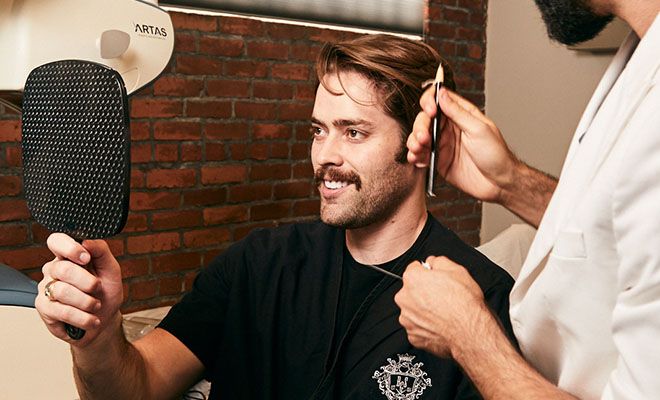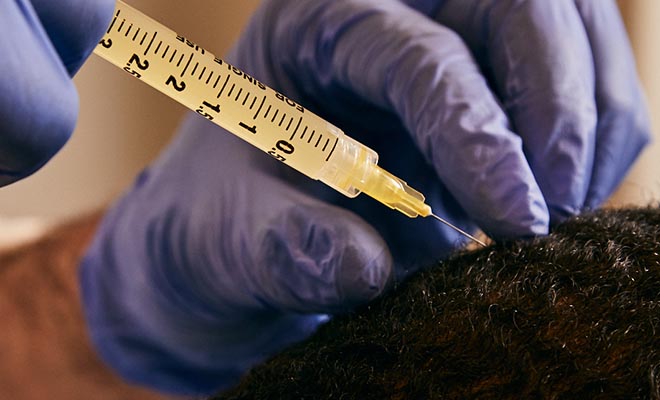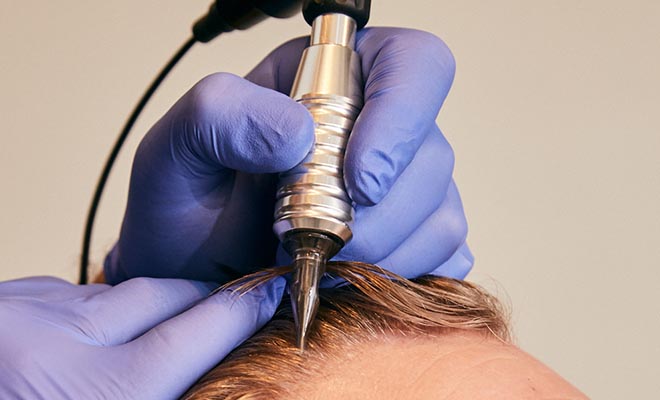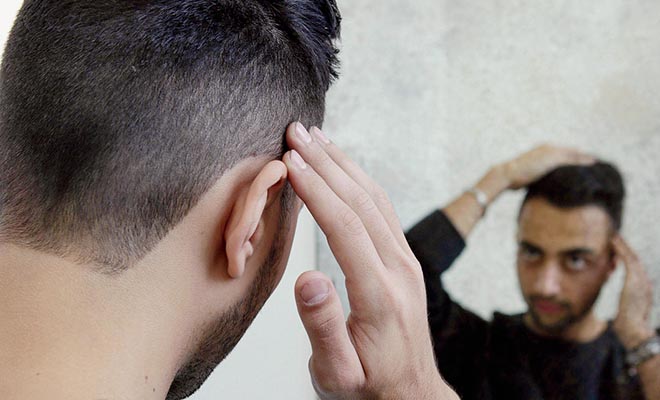Barber Surgeons Guild®
Clinical Grooming Services
Combining Cutting-Edge Robotics With Regenerative Medicine
 Medically reviewed by Barber Surgeons Guild® Founder & Medical Director, Dr. Justin Rome
Medically reviewed by Barber Surgeons Guild® Founder & Medical Director, Dr. Justin Rome
1. Expert Hair Restoration & Restorative Therapies in Los Angeles & New York

2. What is Hair Restoration?
The term hair restoration includes all services and techniques available in the market to restore hair or to give the look of denser hair. Hair restoration techniques include hair transplants, surgical procedures where hair is harvested from donor areas and transplanted to areas of concern using methods like robotic hair restoration and the less-invasive follicular unit extraction (FUE), platelet-rich plasma (PRP) injections, scalp micropigmentation, prescription medications such as Finasteride or Dutasteride, as well as topical applications such as Minoxidil.
Barber Surgeons Guild® specializes in medical hair restoration using cutting-edge technologies and the latest in innovative treatments. Our renowned doctors at our WeHo and Midtown Outposts help men and women looking for hair restoration services in Los Angeles and New York City find the best possible solutions.
When done right, hair restoration can look completely natural. When done wrong it can look artificial. A good way to avoid a poor result is to make sure to review as many before-and-after pictures as possible and to never go with a budget procedure, which often ends up costing more to fix in the long run.
Josh, Hair Restoration Client
Jason, Hair Restoration Client
Justin, Scalp Camo® Client


3. Surgical Hair Restoration or Hair Transplant
Hair transplant is the surgical method of hair restoration. For patients with significant hair loss, it is the only proven way to restore hair growth to areas that have significant hair miniaturization or have gone bald. Recent advancements in hair transplant surgery have made procedures quicker and less invasive, making the surgery easier for patients to undergo while also reducing recovery times for most. Two types of hair transplant methods currently exist: follicular unit transplant (FUT) and follicular unit extraction (FUE).
FUT vs. FUE
FUT restoration involves surgically cutting a strip of skin from the scalp, often an area in the back of the head referred to as the donor area. Small sections of tissue with hair follicles are separated from the strip of skin and individually placed into areas of thinning or balding. This type of surgery can take many hours, has a significant recovery time and creates a noticeable scar along the back of the head where the cut on the scalp has been pulled and sutured.
The FUE restoration technique improves upon the FUT method. Like FUT, it involves harvesting hair follicles from a donor site at the back of the head and moving them to thin or bald areas. However, FUE does not require a strip of tissue to be cut from the scalp. Instead, individual hair follicles are taken directly from the scalp and inserted into recipient sites. While FUE procedures do take more time initially, the FUE method is minimally invasive and eliminates the long scar and significant wound associated with FUT restoration.
FUE has become considerably more popular than the FUT method in recent years, currently accounting for nearly 80% of hair restoration surgeries performed by International Society of Hair Restoration Surgery (ISHRS) doctors. See how the popularity of FUE has grown since 2005 in the following table:
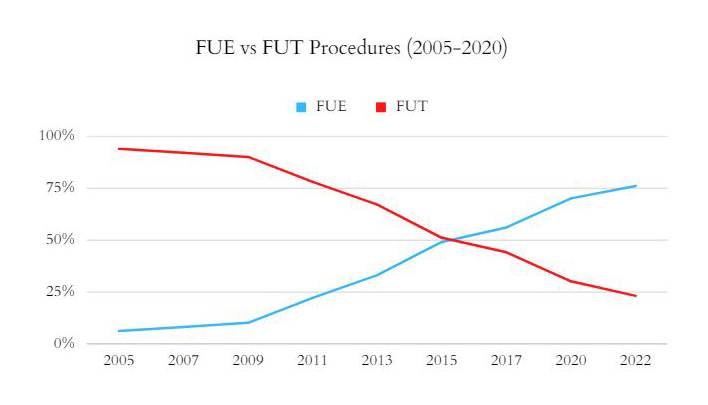
Source: ISHRS Census Data
FUE Pros:
No linear scarring
Quick and relatively painless recovery
Minimally invasive, no scalpel or sutures
Excellent harvest accuracy with Robotic FUE
FUE Cons:
Longer procedure time than FUT
Graft harvesting accuracy is very doctor-dependent with manual FUE
Need to shave back of head to expose donor area
FUT Pros:
Faster procedure time relative to FUE
No need to shave back of head
Much better results than the plug procedure that predated FUT
FUT Cons:
Long linear scar in back of head limits ability to wear hair short
Postoperative pain while the donor strip wound heals
Risk of permanent numbness and phantom pain in back of head from transected nerves
What Is Long Hair FUE?
FUE requires the donor area (back of the head) to be buzzed down to 1mm (no guard). BSG Master Barbers will provide a professional fade prior to the procedure to allow the hair to grow back nicely without the need for a haircut immediately after. While the back of the head heals very nicely after just a week, some people do not want any of the healing process in the back to be visible. Long Hair FUE is designed to effectively hide the donor area with a section of longer hair above. Long Hair FUE requires a section of longer hair in the back of the head (about 2 finger breadths) which can be pinned up above the shaved section. This technique is also known as a window procedure. After the procedure, the longer hair lays down and covers the donor area as it heals. As only a percentage of the hairs are taken from the shaved donor section, the remaining hairs will grow out and eventually match the surrounding hairs.
Do I Have To Shave My Head For FUE?
Patients do not have to shave their heads for Robotic FUE procedures performed at BSG. Many patients will opt to do so anyway, especially for larger full head procedures, but it is never a requirement. Since the donor area must be shaved, BSG Master Barbers will perform a professional fade prior to the procedure, so the hair grows back nicely without the need for another haircut immediately after. Many other clinics will simply shave the back of the head without a fade, leaving the donor area more obvious and the overall look less aesthetically pleasing.
Does Harvested Hair Grow Back After FUE?
Hairs harvested and transplanted during the FUE procedure will grow where they have been relocated. Since these hairs are being removed from the donor area for the procedure, the donor area will thin out to a degree. Regions on the back of the head are selected as donor areas because they have a higher density of hairs and can often support a couple FUE procedures before the area begins to look visibly thin.
We aim to educate on all the options you may benefit from to prevent future hair loss, as well as options to make improvements to your hair.
FUE Vs DHI
Follicular unit extraction (FUE) is a hair restoration procedure that involves extracting grafts as follicular units directly from the back of the head and then implanting the follicular units into recipient areas. FUE can be performed manually or robotically, the procedures for which are very different.
There are a number of different FUE devices and instruments designed for graft harvesting and graft implantation. Examples of follicular unit graft harvesting instruments include the autonomous movement ARTAS Robot (Robotic FUE) and handheld instruments like Neograft® and Smartgraft® (Manual FUE).
Examples of follicular unit graft implantation instruments include specialized forceps, also known as implanting forceps, and instruments designed to implant the graft while simultaneously making the recipient site, such as manual implanting pens. Regardless of how the follicular units are implanted, the procedure is still considered FUE.
DHI®, or Direct Hair Implantation®, is not the name of a new procedure but rather the name of a London-based company (DHI Global®) that markets its namesake as a brand new type of hair restoration surgery exclusive to DHI®. Though DHI Global®’s “DHI® procedure” is marketed as a unique and superior procedure that only DHI® or their franchisees are equipped to perform, the procedure is actually FUE performed with an implanter pen, a procedure that is neither unique or superior to other hair restoration procedures currently available to patients.
Additionally, tools like implanter pens, such as the one being loaded with forceps, are far from new inventions. These tools made their first appearance in the early 1990s, where they were used in FUT / STRIP (Follicular Unit Transplant Technique) hair transplant procedures.
Unlike DHI Global®, Barber Surgeons Guild® does not use implanting pens as these pens require harvesting to be performed prior to recipient site making. We always make recipient sites first to determine how many grafts we need to harvest and to decrease the graft out of body time. Additionally, using implanting pens comes with unique risks to grafts, including needle squeezing, distal hooking, and bulb decapitations, all of which compromise the viability of the graft.

BENEFITS OF FUE WITH BSG
- No linear scarring
- Quick and relatively painless recovery
- Minimally invasive, no scalpel or sutures
- Excellent harvest accuracy with Robotic FUE
- Natural results
- All follow ups included along with maintenance optimization
Speak with our renowned physicians.
ARTAS® Robotic Hair Restoration
Much like FUE hair restoration was an improvement on the FUT technique, robotic restoration continues to improve the efficiency of FUE procedures. BSG’s ARTAS® Robotic Hair Restoration method uses artificial intelligence to identify and harvest the best hair follicles for safe transplanting, while monitoring the appearance and density of the donor and recipient areas, ensuring the final result looks as natural as possible. This robotic FUE technique is minimally invasive and leaves no linear scarring.
ARTAS® Robotic Hair Restoration is the product of years of research and development by engineers working to perfect the hair transplantation process. ARTAS® Robotic Hair Restoration uses the most advanced form of follicular unit extraction (FUE) to harvest hair follicles from the donor area, typically the(back of the head. The harvested follicles are then transplanted into the recipient sites with precision.
The ARTAS® system uses AI, or intelligent algorithms, and 3D imaging to create a personalized and consistent graft of hair and to improve manual techniques. Performed by a BSG physician, the ARTAS® treatment uses a patient’s healthy hair follicles, which is typically permanent and unaffected by male pattern baldness. With the successful treatment of thousands of patients, BSG has developed ARTAS® Robotic protocols for every hair type to maximize the efficiency of this process.
Before & After Robotic Hair Restoration:
The Newest & Most Advanced Hair Transplant Technique
The ARTAS® FUE robot moves autonomously, leveraging AI to make real-time decisions on which grafts to harvest. While a hair restoration surgeon sets and adjusts any number of variables and parameters to guide the robot, there is no controller or joystick of any kind to control the movement. ARTAS® FUE is the most advanced form of robotic surgery that exists today. In the near future, we will begin to see an increase in autonomous robotic surgeries in all surgical subspecialties.
Does Harvested Hair Grow Back After FUE?
Hairs harvested in the FUE procedure will grow where they have been transplanted. As the follicles are being removed from the donor area, the procedure will thin out the donor area to a degree. The donor area is specifically selected because the high density of hairs in this region can often support a couple FUE procedures before the area begins to look visibly thin.
Treatment Without Traditional Surgery & Leaves No Linear Scars
The ARTAS® FUE procedure is performed by a BSG physician without the need for scalpel incisions, stitches or staples. Donor and recipient sites are treated with local anesthetic prior to the procedure, so hair grafts are removed painlessly and with maximum accuracy using ARTAS® robotic technology. The procedure leaves both the donor and recipient areas looking natural with no permanent linear scarring. The ARTAS® FUE hair restoration is a wide-awake, one-day, pain-free procedure after quick, local numbing injections have been administered) with a typically short recovery period of one week where activities must be limited. Though pain is atypical during the recovery process, all patient recovery experiences are different. Post-procedure, we ask that patients rest for a week to support quick healing. Learn more about ARTAS® robotic hair restoration
Neograft Vs Smartgraft Vs ARTAS Vs Manual FUE
Follicular Unit Extraction (FUE) involves extracting grafts as follicular units directly from the back of the head, then implanting the follicular units into recipient areas. This procedure is an advancement over the older Follicular Unit Transplant (FUT), also known as Strip Procedure, where follicular units are trimmed from a strip of skin harvested from the donor area.
When FUE first became popularized in the early 2000s, the only option was manual FUE. Manual FUE refers to procedures where graft harvesting is done via a handheld instrument. Neograft® and Smartgraft® are forms of manual FUE.
Though robotic FUE was FDA cleared in 2008, early robotic FUE procedures were unusably slow compared to manual FUE. Robotic FUE has gained popularity over the last decade as robotic procedures have become faster. Unlike most other surgical robots, the ARTAS® FUE robot moves fully autonomously, leveraging AI to make real-time decisions on which grafts to harvest. The hair restoration surgeon sets and adjusts a number of variables or parameters which guide the robot’s decision making, however there is no controller or joystick for a human to control the movements. ARTAS® FUE is the most advanced form of robotic surgery that exists today. In the near future, we will begin to see more and more autonomous robotic surgeries make their way into all surgical subspecialties.
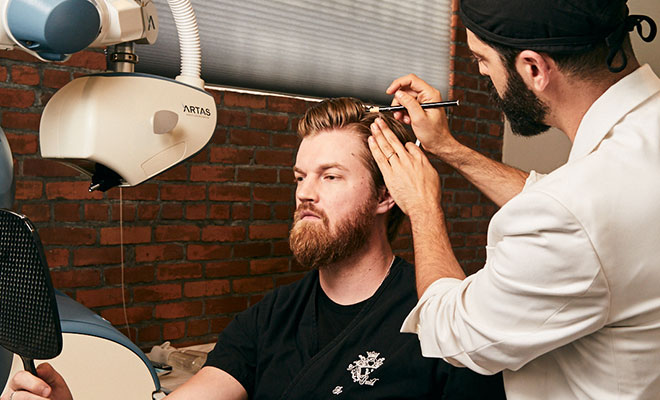
BENEFITS OF ROBOTIC HAIR RESTORATION WITH BSG
- Advanced AI technology
- Eliminates human error/fatigue during procedure
- Protects existing hair follicles
- No linear scarring
- Quick and relatively painless recovery
- Minimally invasive, no scalpel or sutures
- Excellent harvest accuracy with Robotic FUE
- Natural results
- All follow ups included along with maintenance optimization
Speak with our renowned physicians.
We Are Taking Robotic Hair Restoration To The Next Level
Barber Surgeons Guild® has been ranked as an ARTAS® Center of Clinical Excellence. BSG is so respected, in fact, that it serves as a training center for other doctors who learn how to excel with ARTAS® procedures. We do not use dated methods of hair restoration that other clinics still offer because we know our clients deserve the best. This is why all our procedures are done with the highest tech form of follicular unit extraction (FUE).
Unlike procedures performed by most other hair restoration providers, procedures involve robotically harvesting hairs with ultimate precision. This is done through the latest 9x robotic software version, and it ensures you have the best possible outcome. Our all-inclusive “Fill-the-Area” pricing also includes therapies such as PRP—at no additional cost—to give you the head of hair to make you feel like yourself again.
We Are Taking Robotic Hair Restoration To The Next Level
Barber Surgeons Guild® has been ranked as an ARTAS® Center of Clinical Excellence. BSG is so respected, in fact, that it serves as a training center for other doctors who learn how to excel with ARTAS® procedures. We do not use dated methods of hair restoration that other clinics still offer because we know our clients deserve the best. This is why all our procedures are done with the highest tech form of follicular unit extraction (FUE).
Unlike procedures performed by most other hair restoration providers, procedures involve robotically harvesting hairs with ultimate precision. This is done through the latest 9x robotic software version, and it ensures you have the best possible outcome. Our all-inclusive “Fill-the-Area” pricing also includes therapies such as PRP—at no additional cost—to give you the head of hair to make you feel like yourself again.
What Should I Ask When Considering Robotic Hair Restoration?
- Is the practice an ARTAS® Center of Clinical Excellence?
- Is it so highly regarded that it trains other doctors on robotic restoration?
- Is the most up-to-date ARTAS® robotic OS in use (currently vers. 9x)?
- Does the practice focus exclusively high tech procedures, or do they also offer strip harvesting (FUT)?
- Are other effective therapies, such as PRP, combined with robotic hair restoration?
- Do the doctors have off-label experience using the robotic system for Asian hair, Afrocentric hair, Indian hair and with women?
- Have the doctors gained experience treating those in their 20s and 30s?
- Have the doctors performed robotic hair restoration after clients previously had strip procedures?
- Are eyebrow and beard services handled robotically, or are manual techniques utilized?
- Will the office charge you by the graft, or do they offer all-inclusive pricing by the area?
- Do out-of-town patients receive a travel allowance?
BSG’s Renowned Robotic Hair Restoration:
- ARTAS® Center of Clinical Excellence
- Fair pricing structure includes PRP therapy
- Robotic Recipient Site Making
- Robotic Facial Hair Restoration
- Robotic Eyebrow Restoration
- Travel Allowance
4. Nonsurgical Hair Restoration
For those who are concerned about hair loss, but aren’t quite ready for hair transplant surgery, BSG has nonsurgical hair restoration options available, ranging from scalp micropigmentation to medications to scalp injections that use blood growth factors to encourage regrowth.
Scalp Micropigmentation (Scalp Camo®)
Scalp micropigmentation uses fine needles to inject pigment into the scalp to mimic the appearance of tiny hair follicles. This non-surgical technique, referred to as Scalp Camo® at Barber Surgeons Guild®, is designed to give the appearance of greater hair density and add natural-looking depth and definition to thinning hair. Scalp micropigmentation can give the appearance of fuller hair for both men and women of all ages who are experiencing lesser degrees of hair loss.
Scalp Camo® is a safe, quick, non-surgical option for hair restoration that has long been used by celebrities, actors and high-profile professionals to immediately address obvious thinning or to enhance the appearance of finer hair by decreasing the contrast between scalp and hair.
Scalp Camo® is a procedure where pigment is injected epidermally—that is, the micro-fine needles used in the procedure do not penetrate beyond the outermost layer of skin—and can be applied to any site where hair is thinning. The crown, back and sides of the head, frontal and temple hairlines, balding spots and prior scarring from follicular unit transplant (FUT), also known as strip surgery, can be cosmetically filled in to give the appearance of greater hair density. Learn more about Scalp Camo®.
Before & After Scalp Micropigmentation:
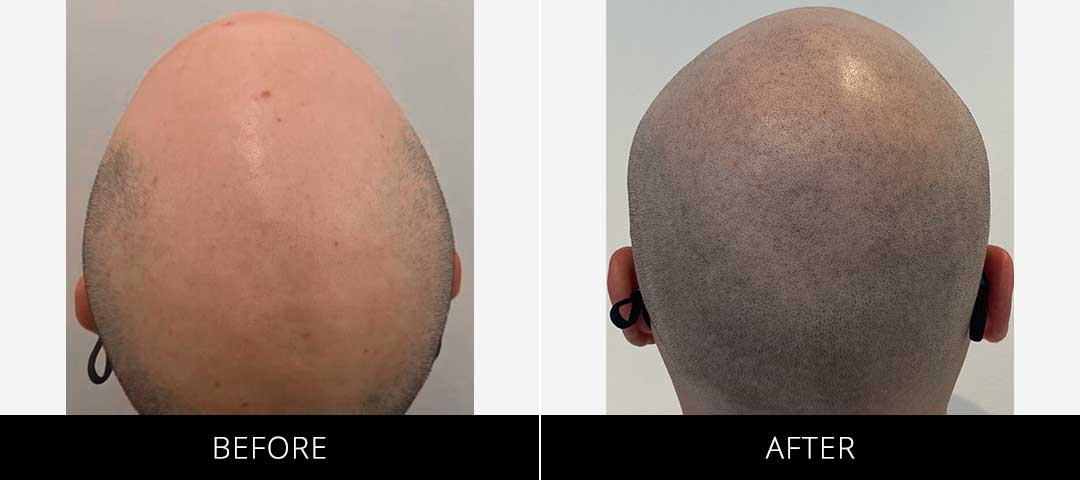
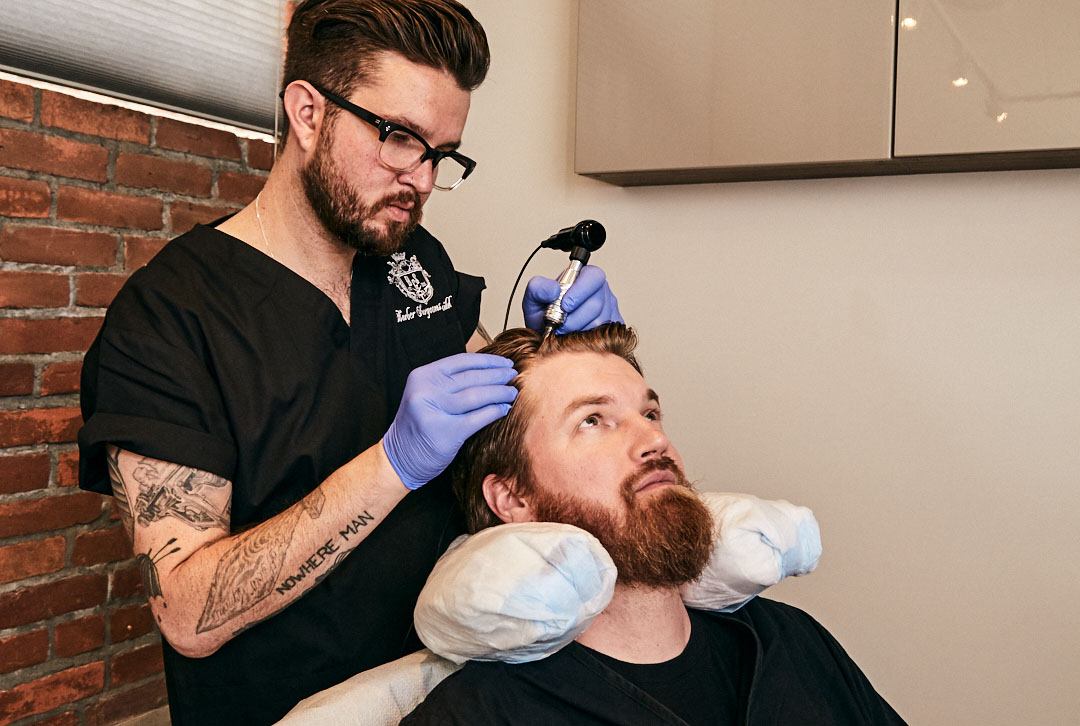
BENEFITS OF SCALP CAMO® WITH BSG
- Immediate result & appearance of added hair density
- Non-surgical procedure
- Comfortable & safe
- No Downtime
- Lasts up to 5-10 years
- Perfect option if area is not thin enough to need restoration
Speak with our renowned physicians.
Platelet-Rich Plasma Therapy
Platelet-Rich Plasma Therapy (commonly referred to as PRP) is a non-surgical treatment option for hair restoration that uses the growth factors in a patient’s own blood to encourage growth and help restore hair. First, platelet-rich plasma is isolated from a patient’s drawn blood, and then tiny amounts are injected into the scalp, targeting areas of hair loss and thinning. BSG’s PRP Maintenance Therapy is designed to help thicken and increase the volume of existing hair and slow down future hair loss.
Long utilized by professional athletes and orthopedic surgeons to aid in recovery from injury or surgery, PRP is one of the latest in innovative and non-surgical therapeutic treatments for hair loss. Platelet-rich plasma or autologous conditioned plasma is derived from whole blood and centrifuged to remove red blood cells, leaving a concentrate of platelet-rich plasma. Within this isolated fraction are numerous essential growth factors that stimulate hair thickening and combat androgenetic alopecia, the medical term for male pattern baldness, or male pattern hair loss due to DHT (Dihydrotestosterone). The prominent growth factors found in PRP, include vascular endothelial growth factor (VEGF), epidermal growth factor (EGF), platelet-derived growth factor (PDGF), fibroblast growth factor (FGF), transforming growth factor β (TGF-β), and insulin-like growth factor (IGF).
Before & After PRP Treatment:

Going Beyond Conventional PRP Treatment by pairing the derived platelet-rich plasma with Adenosine triphosphate (ATP)
BSG enhances the effectiveness of PRP treatments for hair restoration by pairing PRP with Adenosine Triphosphate (ATP). ATP is the organic compound for energy storage. Each ATP molecule has a specific amount of energy and all of the work done in our bodies from contracting a muscle, to growing a hair is done by using the energy stored in ATP. We eat and breathe to bring in nutrients and oxygen which are used together to charge up used ATP (known as ADP or Adenosine diphosphate) back into more ATP. This is the process known as aerobic respiration. We now have the ability to create ATP in the lab and use it as a medical therapy. BSG’s PRP Maintenance protocol includes applying an ATP solution to the scalp immediately after a session of scalp micro-needling to help the molecule get to the follicles where it can help provide additional energy for growth.
PRP, being naturally derived, is safe, and PRP treatments are relatively painless (as we quickly numb the area prior to treatment) and produce natural results. The procedure itself is quick, only requiring about 30 minutes. We offer our PRP Maintenance program at a sustainable rate to ensure long-term success for our patients. Learn more about Platelet-Rich Plasma treatment.
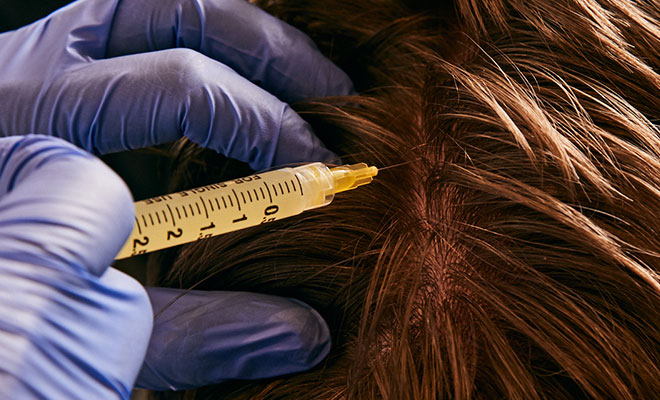
BENEFITS OF PRP WITH BSG
- Naturally derived
- Non-surgical procedure
- Simple, pain-free, & safe
- Quick, 30min procedure
- Fast recovery period
- Natural results
Speak with our renowned physicians.
Exosome Therapy
Exosome therapy is a non-surgical hair restoration treatment. While stem cells are a unique type of cell found in the body from which all other cells with specialized functions are derived, exosomes are membrane-bound extracellular vesicles or small protein particles released from stem cells that give them the faculty to regenerate new tissue. These nano-particles are 1/1000th the size of a stem cell.
Exosomes provide cellular communications (between cells) and carry genetic information and over 1,000 protein growth factors to cells throughout the body. These proteins stimulate healing, anti-inflammatory responses and cellular growth. Since exosomes can travel through barriers too large for other cells, they more efficiently disperse healing factors, which, in turn, help to regenerate new tissue, including hair follicles. Essentially, exosomes are the critical growth factors hair follicles need to produce thick, healthy hair strands.
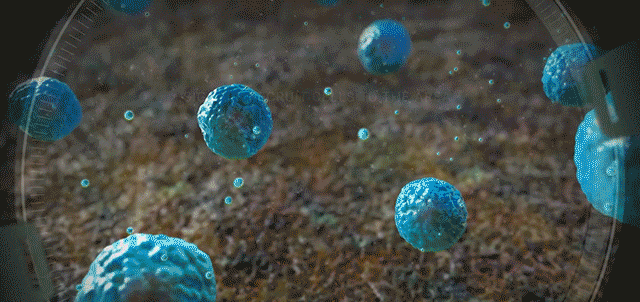
Exosome signaling proteins recruit cells for healing through a natural process.
How Exosomes Are Used to Restore Hair
Exosome therapy for hair loss is a hair restoration option for both men and women that can be used in both the early and later stages of hair loss. Exosomes can also be used in combination with platelet-rich plasma (PRP), low-level light therapy, and surgical hair restoration procedures to specifically target areas in need.
Currently, two methods are commonly offered in exosome therapy for hair restoration. The first exosome method involves injecting a serum into the scalp while the second exosome method resembles micro-needling. Research shows that both of these methods are viable. Currently, injections similar to those given in PRP treatments are the most common way to deliver exosomes. Although, there is evidence that injections followed by micro-needling may be the most effective protocol.
In exosome therapy, the exosome serum is injected into thinning or affected scalp areas. Injections are spaced carefully to maximize the effects. Once administered, the exosomes begin their work repairing, healing and restoring the damaged hair follicles and skin cells. With the cells supported and stimulated, the hair begins to regrow naturally, giving the patient fuller, thicker hair in time.
Regarding recovery, patients can resume daily activities a day after the treatment, though the scalp may feel a bit sensitive for about a week. Hair growth can start as soon as eight weeks after treatment and continue over the course of a year. Typically, patients see noticeable results about six months after treatment. How lasting the results are can vary from person to person. Learn more about Exosome therapy.
Before & After Exosome Therapy
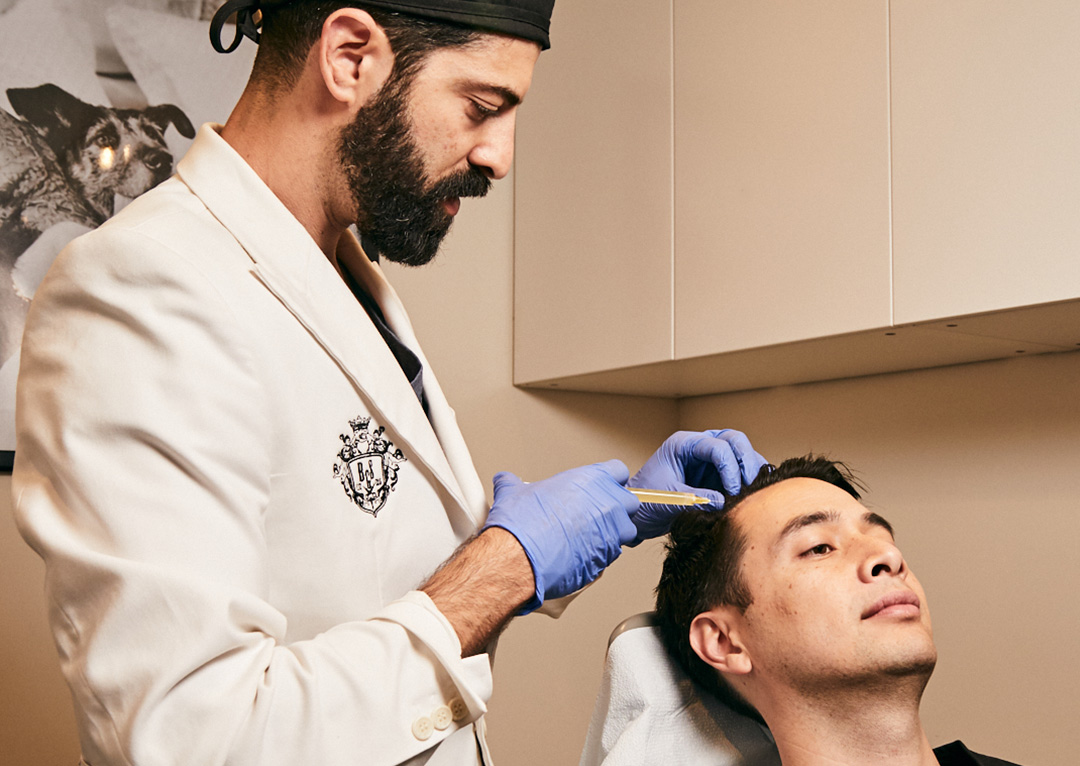
BENEFITS OF EXOSOMES WITH BSG
- Cellular regeneration
- Useful for both men & women
- Can be applied in early and/or later stages of hair loss
- Can be combined with other therapies
- Sustained hair regrowth period
- Naturally derived
- Non-surgical procedure
- Safe and effective
- Fast recovery period
- Natural results
Speak with our renowned physicians.
Oral & Topical Medications
Several FDA-approved oral and topical medications exist that slow or reverse mild hair loss. The most common over-the-counter treatment is the topical medication Minoxidil. Minoxidil is applied directly to the scalp and may gradually lead to thicker hair. However, Minoxidil alone is typically not enough to achieve the desired results.
Finasteride and Dutasteride are oral medications for men used to treat male pattern baldness. Of the two medications, the U.S. Food and Drug Administration has only approved Finasteride as a hair loss drug in the United States. Still, research shows that both medications do help promote hair growth in men with male pattern baldness. Effectiveness of these oral treatments may depend on continued use of the medication.
Finasteride and Dutasteride can also be administered topically to treat hair loss. Topical Finasteride and topical Dutasteride give patients a way to use these medications without having to take them orally. These compounded medications can be applied directly to the scalp.
5. Cost Of Hair Transplant
The cost of hair restoration will vary greatly depending on how much hair needs to be restored, the type of procedure being performed, and the overall quality of the treatment facility. Though they are strongly not recommended, budget hair restoration procedures are often available overseas in countries like Turkey, and cheaper procedures in the U.S. can be found by opting for FUT over FUE. In general manual FUE is less expensive than robotic FUE. However at Barber Surgeons Guild®, we competitively price our robotic FUE alongside market manual FUE prices. On average, hair restoration costs between $5,000 and $20,000, with the majority of cases being somewhere in the middle. Most hair restoration centers will quote by the graft, however at BSG we charge by the area which gives us the flexibility to obtain the right number of grafts based on your needs Learn more about our pricing structure.
BSG Doesn’t Charge By The Graft
Rather than charging by the graft like other clinics, BSG approaches pricing differently. Our surgical treatment plans are more focused on aligning with patients on results and restoring hair style. We’ve found that holding strictly to some predetermined graft number is less helpful to our patients. While our approach to pricing is highly uncommon in the world of hair restoration, it has been our approach since BSG first opened. For us, it’s the difference between hearing our patients say, “My hair looks great” versus, “My 2,000 grafts look great”. There are a number of factors that determine how many grafts a patient will need to achieve desired results, and this number is never so neatly rounded. When patients sign up for a fixed number of grafts, they will either not get enough hair, or, possibly worse, their donor area will have been overharvested and their donor supply depleted unnecessarily. Overharvesting the donor area could prevent a patient from treating future hair loss with additional hair restoration.
On the day of the procedure, BSG hair restoration surgeons begin the day with planning, which involves mapping out the areas where hair will be transplanted. The planning process is very detailed, and the doctor and patient (along with a partner, if desired) will work together until a fully agreed upon plan is chosen. After planning, the doctor will make the recipient sites for the new grafts based on the final approved drawings. From the drawings, the doctor will determine the number of recipient sites to be made and the corresponding number of grafts required. Drawing a plan the day of surgery ensures we will never over- or under-harvest. We determine exactly what is needed and then harvest the grafts accordingly.
Out of body time of grafts can impact graft viability. Since our surgeons make recipient sites before harvesting grafts, we’re able to minimize out of body time of the grafts. Upon harvesting, grafts can be placed quickly since the recipient sites have already been made. In fact, our surgeons typically place grafts at the same time as they are harvested, a technique that BSG founder, Dr. Rome, presented at a major hair restoration conference.
Regarding grafts generally, there is poor consensus into what is considered a graft–is it a hair? Is it a follicular unit? etc. Often, larger unit grafts are trimmed into more than one graft when single haired grafts are needed to build up a hairline. While this is an appropriate use of graft duplication, some clinics will use this practice to simply increase graft counts, a practice we believe is unethical as it leads to less hair transplanted for the sake of meeting a predetermined number of grafts. In addition, this technique also poses unnecessary risk to the grafts, as they are undergoing dissection without cause. At BSG, we never cut down grafts beyond the need to get enough singles for the hairline. In fact, in the case of fine hair with lower numbers of hairs per follicular unit, we will often create larger grafts from smaller ones. This practice effectively decreases our graft count, but allows us to double the number of hairs transplanted. For example, if an individual had all two-haired follicular units and had 1,000 units harvested, cutting each unit into two grafts would yield, a total of 2,000 grafts to be placed. If none of these units were cut, 1,000 grafts would be placed. If each of these grafts were grouped together to create four-haired grafts, 500 grafts would be placed. In each example, the same 2,000 hairs are placed, though the technical graft count varies wildly in each scenario (2,000 to 1,000 to 500). This is exactly why charging by the graft can be confusing and misleading.
Barber Surgeons Guild® is fully committed to achieving the best possible results, so we take care to harvest the appropriate number of grafts needed to achieve a desired outcome. By structuring costs this way, we have no motivation to under-harvest.
How Much Does 2000 To 5000 Grafts Cover?
The amount of area covered by hair grafts varies based on a number of factors. See the questions below to better understand the factors hair restoration surgeons must consider when determining how many grafts are needed for a patient.
- How much hair is present?
The density of existing hair is a primary factor in determining how many grafts will be required to restore the look of fuller hair. 2500 grafts can cover up a full head if there is hair everywhere, but not great density anywhere. On the other hand, without any hair present at all, 2500 grafts would cover just half a head. - Are the hair follicles fine or thick?
Fine hair requires more grafts to cover the same area than thick hair does. - Is the hair straight or curly?
Straight hair requires more grafts to fill an area than curly hair which takes up more volume. - What is the average number of hairs per follicular unit?
There is great variation in numbers of hairs per follicle unit which is mostly determined by race. For example, while Asian hair has far fewer hairs/unit than Caucasian hair, Asian hair follicles are usually thicker than caucasian hair follicles. The number of hairs/unit will also determine how much coverage is achieved with a certain number of hair grafts.
It is worth mentioning that transplanting in excess of 30-40 follicular units per square centimeter will lead to decreased graft growth due to limited blood supply. It is much safer to do two 2000 graft procedures over 2 years than one 4000 graft procedure where many of the grafts will not take. In the USA, it is rare that any doctor will perform a procedure over 3000 grafts for this reason. Be wary of anyone suggesting 3000+ grafts, as they are either talking about hairs and not grafts or they are okay with the risk of graft failure.
How Much Is A Hair Transplant In Los Angeles?
The cost of hair restoration will vary greatly depending on how much hair needs to be restored, the type of procedure being performed, and where you go. Budget hair restoration procedures can be obtained by traveling to Turkey, and cheaper procedures in the USA can be obtained by opting for FUT over FUE. In general, manual FUE is less expensive than robotic FUE, however, at Barber Surgeons Guild®, we competitively price our robotic FUE alongside market manual FUE prices. On average, hair restoration in Los Angeles costs between $7,500 and $20,000, with the majority of cases being somewhere in the middle. Most hair restoration centers will quote by the graft, however at BSG we charge by the area which gives us the flexibility to obtain the right number of grafts based on your needs. Learn more about our Lost Angeles Outpost.
How Much Is A Hair Transplant In New York?
The cost of hair restoration will vary greatly depending on how much hair needs to be restored, the type of procedure being performed, and where you go. Budget hair restoration procedures can be obtained by traveling to Turkey, and cheaper procedures in the USA can be obtained by opting for FUT over FUE. In general manual FUE is less expensive than robotic FUE, however at Barber Surgeons Guild®, we competitively price our robotic FUE alongside market manual FUE prices. On average, hair restoration costs between $8,000 and $20,000, with the majority of cases being somewhere in the middle. Most hair restoration centers will quote by the graft, however at BSG we charge by the area which gives us the flexibility to obtain the right number of grafts based on your needs. Learn more about our New York Outpost.
6. Our Approach To Hair Restoration
BSG aims to align with our patients on results and will never charge by graft. We were founded with style-first considerations, hence the inclusion of a grooming lounge staffed with Master Barbers. We are much more than a hair restoration clinic. In our outposts, we can leverage the most advanced medical technologies to achieve the best hairstyles for individuals who require more hair to meet their style goals.
We perform more robotic FUE than any other center in NYC or LA. Our large caseload has allowed us to develop internal protocols for every hair type from curly to straight, fine to thick, etc. No clinic is more experienced in robotic FUE than BSG.
Finally, our hair restoration surgeons are all highly experienced in the field of hair transplantation and each is a member of the International Society of Hair Restoration Surgery (ISHRS).
Why The Name Barber Surgeons Guild®?
Hair restoration is equal parts art and science. When the art is overshadowed by the science, aesthetic results become compromised. The BSG namesake originates from the legacy trade of the Barber Surgeon who was responsible for all barbering and surgery from the 11th century through the late 17th century. Modern surgery was based on the contributions of the barber surgeons who first performed everything from tooth extraction to amputations. While barbers and surgeons have since separated over the last few hundred years, we’ve reunited these two trades to combine the art of hairstyle with modern medicine.
Which Type of Hair Restoration Is The Best?
When you’re determining the best type of hair restoration, you must consider much more than the type of graft harvesting that is used (i.e., FUE vs FUT). Determining the best type of hair restoration starts with a style plan that aligns with the individual’s goals. The best hair restoration also requires a surgeon who has a deep understanding of hairline aesthetics and natural anatomy, the knowledge required to rebuild a new hairline and/or to address other areas of hair loss properly. Proper graft handling, which refers to short graft out of body time and proper graft chilling, is important and affects graft viability. Other factors including, the type of harvesting and the experience the center and doctors have with the particular harvesting technique are also important. BSG specializes in Robotic FUE and performs more of these procedures than anywhere else in NYC or LA, making us foremost experts in this space. BSG takes pride in offering what we truly believe to be the best hair restoration procedures from every perspective.
Where Do Celebrities Get Hair Transplants?
Unless a celebrity discloses themselves where they had a hair transplant, it is impossible to determine where they went for a procedure. Healthcare privacy laws protect patient information, including those of celebrities. As we can only speak for ourselves, BSG has treated many celebrities from actors to musicians to professional athletes of every major sports league. The procedures BSG performs on celebrities are the same exact procedures we perform on each and every patient.
Who Is The Best Hair Transplant Surgeon In The United States?
While we can only speak for ourselves, BSG hair transplant surgeons perform more robotic FUE in New York City and Los Angeles than any other hair restoration center. Our hair transplant surgeons are all members of the International Society of Hair Restoration Surgery (ISHRS), and each has an extensive history of performing the most advanced procedures to treat hair loss. Patients travel from all over the world to have their restoration procedures performed by BSG surgeons. If you are interested in traveling from out of state or beyond, please contact us and ask about our travel credits available.
How Do I Choose A Doctor For Hair Transplant?
When you’re choosing the best doctor for a hair transplant, ensure that the doctor has significant experience in the field of hair restoration. Ask to see before and after photos. Read reviews. Ask if there are patients they have treated who they can speak to as a reference. See if the doctor is a member of the ISHRS (International Society of Hair Restoration Surgery). Meet the doctor for consultation and see if you connect and can align on a plan. Ask if they have full time surgical assistants or if they use all contracted labor for support. Patients travel from all over the world to have their restoration procedures performed by BSG surgeons. If you are interested in traveling from out of state or beyond, please contact us and ask about our travel credits available.
How Do I Choose A Hair Surgeon?
Choosing a hair surgeon is a big decision and an important one. Ensure the surgeon has significant experience in the field of hair restoration. Ask to see before and after photos. Read reviews. Ask if there are patients they have treated who they can speak to as a reference. See if they are a member of the ISHRS (International Society of Hair Restoration Surgery). Meet the surgeon for consultation and see if you connect and can align on a plan. Ask if they have full time surgical assistants or if they use all contracted labor for support. Patients travel from all over the world to have their restoration procedures performed by BSG surgeons. If you are interested in traveling from out of state or beyond, please contact us and ask about our travel credits available.
What Is The Best Age To Get A Hair Transplant?
While anyone over 18 years of age can legally get a hair transplant procedure, most hair restoration centers prefer to medically manage hair restoration patients until they are in their 20s. According to the most recent 2022 ISHRS census report, men under 20 years of age accounted for only around 2% of procedures performed.
Hair restoration for people in their 20s is quite common, and, based on the census report referenced above, accounts for over 18% of all hair transplant procedures performed. The most common age by decade to have a hair transplant done is the 30s, which account for nearly 30% of all hair transplants performed. According to the most recent 2022 ISHRS census report, the average age for hair transplants is in the 30s. Based on the graph below, 77% of men were under 49 years old, 49% were under 39 years old, and 20% were under 29 years old.
How Long Does Hair Restoration Last?
Hair restoration is permanent. When men lose all their hair, they still maintain the permanent or DHT-resistant hairs around the “horseshoe” or donor area. This is the hair used in transplantation and wherever relocated, these special hairs will never fall out. It is very important for anyone who has had a hair transplant to make sure they follow proper medical management to prevent future hair loss as much as possible in order to avoid the need for more and more hair transplants. While it may seem ideal for some to simply keep resorting as more hair is lost, there is not enough donor hair to accomplish this. For this reason, hair transplantation is unfortunately not an option for guys who have already lost all of their hair.
Take A Tour Of BSG
BSG specializes in the most high tech treatment options to maintain and restore your hair. Click to watch a video of our facilities and learn about our services.
Cutting-Edge Solutions
Our clients expect only the best and most advanced hair restoration procedures when they visit us. You shouldn’t have to suffer the downfalls of hair loss. Luckily, our solutions mean that you don’t have to. It’s possible to achieve natural results while avoiding the linear scarring and downtime of dated procedures that many clinics still provide.
Located In Los Angeles & New York Specializing In Robotic Hair Restoration
LA Outpost
WEST HOLLYWOOD
805 Larrabee St.
Los Angeles, CA 90069
Hours of Operation
Hair Restoration & Maintenance
Monday – Friday 9:00 AM – 5:00 PM
Barbershop
Monday – Saturday 10:00 AM – 7:00 PM
Sunday 10:00 AM – 6:00 PM
NYC Outpost
MIDTOWN
240 W 37th St., 5th Floor
New York, NY 10018
Hours of Operation
Hair Restoration & Maintenance
Monday – Friday 9:00 AM – 5:00 PM
Barbershop
Monday – Saturday 10:00 AM – 8:00 PM
Sunday 10:00 AM – 6:00 PM





